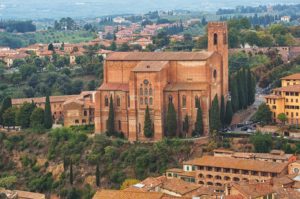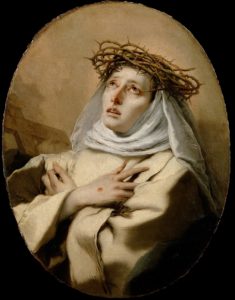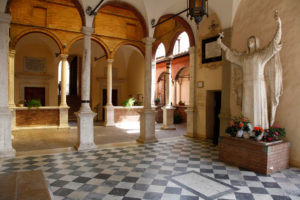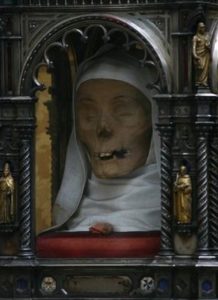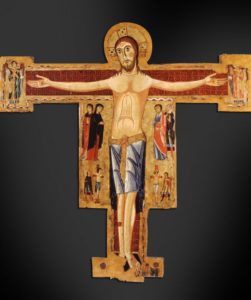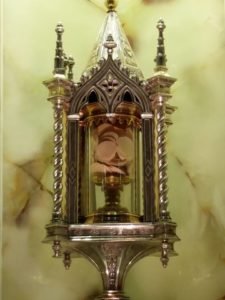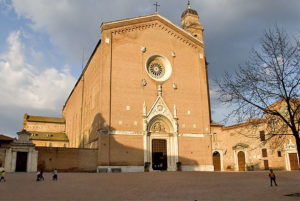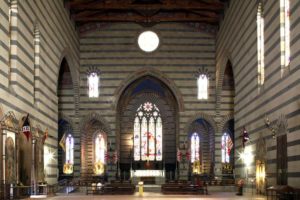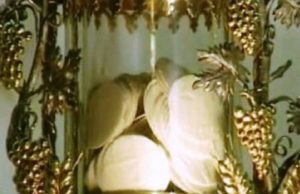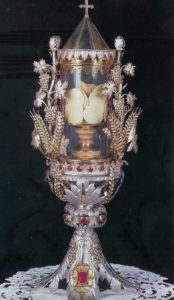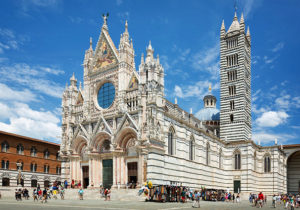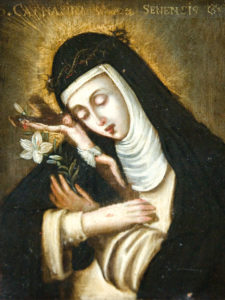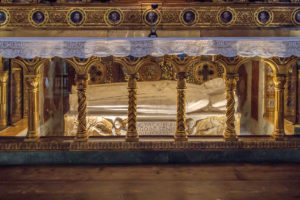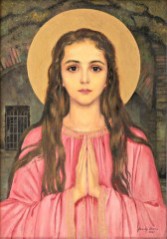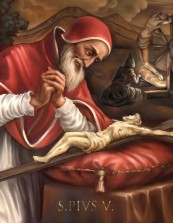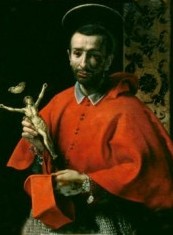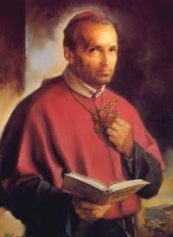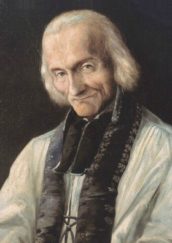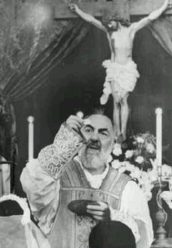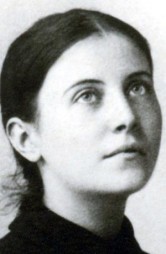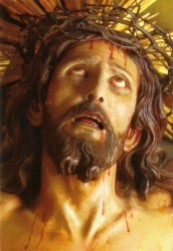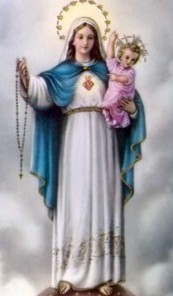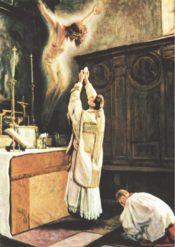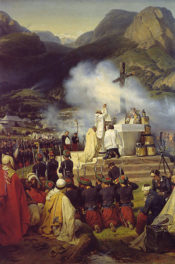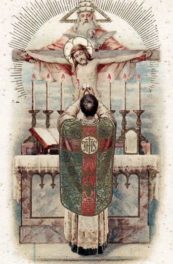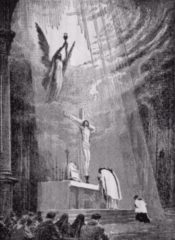Siena: Saint Catherine of Siena; Ongoing Eucharistic Miracle
About 70 km south of Florence, in central Italy’s Tuscany region, lies Siena, one of the country’s most visited medieval cities. It is easily accessible by bus and train (from Florence as well as Rome and other Italian cities).
SAINT CATHERINE OF SIENA
Siena, famous for being the birthplace of the 14th century mystic Caterina Benincasa, or Saint Catherine of Siena, is also one of a dozen or so places where one can, to this day, see a continuous Eucharistic miracle.
To learn more about the life, mystical gifts, visions and miracles of St. Catherine of Siena, as well as her role in bringing to end the Great Western Schism, have a look at this wonderful article: catholicism.org/saint-catherine-of-siena.html.
There are a number of places in Siena connected to the saint.
Home-Sanctuary of St. Catherine (Via Costa di Sant’Antonio 6; daily 9:30am-7pm; Church of the Crucifix daily 9:30am-12:30pm/3pm-7pm; www.enjoysiena.it/it/attrattore/Casa-Santuario-di-Santa-Caterina-da-Siena)
The Benincasa family home, where Catherine (one of 25 children) was born and raised, was converted into a sanctuary not long after her death. Part of the sanctuary is the church of the Sacred Crucifix, built in the 16th century in the place of the former garden to house the miraculous crucifix from which St. Catherine received the stigmata in 1375. Visitors can view numerous paintings related to the saint’s life as well as the cell where she slept, the stone she used for a pillow, and several other objects she used during her life. Various rooms of the original Benincasa house have been converted into small oratories.
Basilica Cateriniana San Domenico (Piazza San Domenico 1; March-October: daily 7am-6:30pm, November-February: 9am-6pm; www.basilicacateriniana.com/index_en.html)
The Basilica of St. Dominic is an imposing Dominican Order church dating back to the 13th century. (St. Catherine herself was a Dominican tertiary.) The basilica houses her relics – most notably her incorrupt head and right thumb, as well as artworks depicting her life.
St. Catherine died in Rome in 1380, at the age of 33. When her body was – after reports of numerous miracles – transferred from the cemetery to the Basilica of Santa Maria sopra Minerva, Blessed Raymond of Capua, St. Catherine’s spiritual director and Master General of the Dominican Order, with permission of Pope Urban VI, separated the head from the body so that the head could be sent to Siena, to be exposed publicly after her canonization.
The rest of her incorrupt body lies beneath the main altar in the Basilica of Santa Maria sopra Minerva in Rome (except for her left hand which is in the monastery church of Madonna del Rosario in Rome, and her right foot which can be seen in the Basilica of Saints John and Paul in Venice).
St. Catherine’s feast day is April 29.
EUCHARISTIC MIRACLE OF SIENA
Basilica di San Francesco (Piazza San Francesco 6; daily 7:30am-12pm/3:30-7pm; www.enjoysiena.it/en/attrattore/Basilica-of-San-Francesco/)
Siena is also home to a Eucharistic miracle which is one of the longest ongoing miracles in the world. Like the other permanent (continuous) Eucharistic miracles preserved to this day (most famous of which are in Lanciano, Italy, and Santarem, Portugal), it is a gift of God’s love meant to strengthen our faith in the Real Presence of Our Lord in the Eucharist.
On August 14, 1730, thieves broke into the Church of St. Francis and stole a ciborium containing consecrated hosts. The theft was discovered the next day by Franciscan priests, and the town’s festivities celebrating the Feast of the Assumption were immediately halted. The bishop asked for prayers and reparations as civil authorities searched for the missing ciborium and hosts.
On August 17, a parishioner in the Church of St. Mary noticed a bright light coming from a collection box. When the box was opened a large number of hosts was discovered covered by dust and cobwebs. Counted and examined, these were determined to be the same hosts (348 whole hosts and 6 halves) that were stolen.
On August 18, the archbishop of Siena, in a magnificent procession, carried the hosts (placed in a ciborium) back to the Church of St. Francis. A huge crowd of people from all walks of life and social classes followed the archbishop and the clergy of Siena along streets which had been decorated for the joyous occasion.
Normally the priests would have consumed these hosts but since the dust and dirt could not be entirely removed from them it was decided to let them decompose naturally, something that should have taken a few weeks. But the hosts did not decompose. They have remained as fresh and as pleasant smelling as on the day they were first baked.
Over the years various examinations and tests have been performed that authenticate this miracle. The first official investigation took place in 1780. The hosts were examined and tasted, and confirmed to be fresh and incorrupt. Further investigations by special commissions were done in 1789, 1815 and 1850. During the 1789 examination the archbishop had several unconsecrated hosts placed in a sealed box which was then kept under lock in the chancery office. When it was opened, several years later, the hosts were found disfigured and extremely deteriorated.
The most significant investigation took place in 1914 by a special commission composed of various Italian scientists and professors, as well as several theologians and Church officials. An acid and starch test was performed, and particles of the hosts were again tasted. It was determined that he hosts had been made of roughly sifted wheat flour and that they were perfectly preserved. The commission agreed that unleavened bread, prepared and kept under ordinary conditions (as was the case with these hosts) could not have remained intact for such a long time, and that no natural explanation could be found to explain the remarkable preservation of bread since 1730.
In 1922 cardinal Tacci, accompanied by the archbishop of Siena and four bishops, again examined the miraculous hosts. As in all previous examinations, they were found to be perfectly preserved and fresh tasting. Yet another investigation took place in 1950 when the hosts were transferred to a more elaborate container. By this time there were 223 hosts, the others having been distributed in communion on a few occasions and used in tasting during the various examinations.
On August 5, 1951, another sacrilegious theft took place in the Church of St. Francis involving the miraculous hosts. This time, however, the thief took only the precious container, leaving the hosts on the altar. The archbishop then placed the hosts in a silver ciborium, and sealed it. The following year the archbishop, in the presence of a number of witnesses, took the hosts out of the ciborium, counted and examined them, and had them photographed. They were then transferred into an elaborate monstrance specially constructed for this purpose.
The most recent examination of the sacred hosts was carried out in 2014. It included surface investigation under digital microscope, determination of the nucleotide adenosine triphosphate (ATP), culture tests, etc. It confirmed the hosts remain unchanged and free from any abnormalities or decay, contrary to the laws of nature.
The 223 miraculous hosts are preserved to this day in the church (now Basilica) of Saint Francis. They are publicly displayed several times a year, including on the 17th day of each month (which was the day of the month that they were discovered by the parishioner). On the Feast of Corpus Christi the hosts are taken in procession through the streets of Siena.
While in Siena, make sure to also visit the beautiful cathedral (Duomo). For a handy list – with contacts, opening hours and main attractions – of all the churches and sanctuaries in Siena, see the link here.
Sancta Catharina, ora pro nobis!
St. Catherine of Siena:
Life of Saint Catherine of Siena (Bl. Raymond of Capua) – pdf, text, epub, kindle format
Saint Catherine of Siena (A. Masseron) – pdf, text, epub, kindle format
St. Catherine of Siena and Her Times (M. Roberts) – pdf, text, epub, kindle format
The History of St. Catherine of Siena (A. T. Drane) – volume I, volume II
The Dialogue of St. Catherine of Siena – pdf, text, epub, kindle format; or audiobook here
Letters of St. Catherine of Siena – pdf, text, epub, kindle format
Eucharistic Miracles:
The Eucharistic Miracles around the World (with photos) – pdf
Ancient Miracles of the Blessed Sacrament – audio

